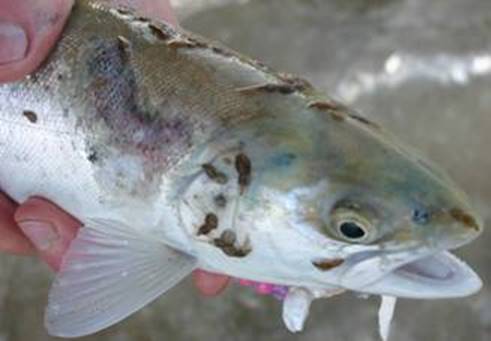Scottish Government has laxer standards on control of sea lice parasites than any other salmon farming country in the North Atlantic
Scotland came under heavy fire and was publicly shamed last week at the 33rd Annual Meeting of the inter-governmental North Atlantic Salmon Conservation Organisation (NASCO) over its continuing failure to have in place effective regulation to control numbers of deadly sea lice parasites on salmon farms – in order to prevent deadly infestation of vulnerable wild salmon and sea trout.
The Meeting in Germany included a full day Special Session “Addressing impacts of salmon farming on wild Atlantic salmon” and delegates from over 20 countries focused on the differing regulatory regimes.
Andrew Graham-Stewart, Director of Salmon & Trout Conservation Scotland (S&TCS), said:
“It is abundantly clear that Scotland lags far behind all the countries in the North Atlantic with salmon farming industries, including Norway, Canada, Ireland and the USA, when it comes to protecting wild fish from the impacts of salmon aquaculture. The contrast between the strict statutory controls elsewhere and the paucity of regulation in Scotland is extreme.”
Mr Graham-Stewart continued:
“When it comes to the most serious threat to wild salmonids, sea lice produced by the billion on salmon farms, Scotland essentially relies on what are little more than gentleman’s agreements and unenforceable codes of good practice with the industry which have no status in law. In contrast, the Faroese have almost zero tolerance of any build-up of sea lice and the Norwegians accept no more than 0.5 lice per farmed fish. Yet the Scottish regime now allows up to an astonishing eight lice per farmed fish before any serious remedial action must be considered.”
Paul Knight, CEO of Salmon & Trout Conservation UK (S&TC UK) and co-Chair of the NASCO NGOs, elaborated:

Sea lice grazing on and destroying the skin and protective mucous of a sea trout. Such an infestation of sea lice is very likely to be fatal.
“It was very noticeable amongst the NGOs present that, although none of them thought their respective Governments were doing enough to protect salmon from aquaculture, they were all astonished at just how lax Scotland is and how the Scottish officials appear deluded that their latest plans for supposedly tougher regulation will provide any meaningful protection to wild salmon and sea trout. The NASCO forum is purely about the protection of wild fish, and Scotland is presently at the bottom of the heap in terms of limiting the impact of aquaculture on its wild salmon stocks.”
Hughie Campbell Adamson, Chairman of S&TCS, added:
“It is a sad state of affairs when Scotland has considerably weaker regulation than even the Faroes. Anyone who has seen immature salmon and sea trout in the west Highlands and Islands being eaten alive by these sea lice will understand that the Government’s comprehensive failure to introduce proper protection for our wild fish is Scotland’s shame.”
Sea lice grazing on and destroying the skin and protective mucous of a sea trout. Such an infestation of sea lice is very likely to be fatal.
The latest sea lice data for January to March 2016, published by the Scottish Salmon Producers’ Organisation (SSPO) on 20 May, confirms that the industry is still failing to control the parasites in many areas, indeed there is no sign of any real improvement. As the graph below shows, the trendline for the percentage of total industry production capacity above the Code of Good Practice threshold (for recommended treatment) is on a steady upward trajectory.










